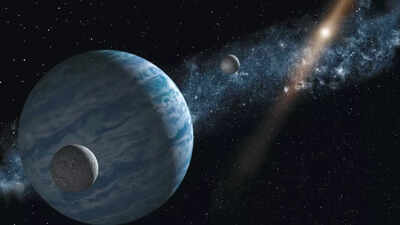Trending
A 9th planet in our solar system? Scientists finally find a potential candidate to ‘replace’ Pluto
Astronomers may have found a candidate for Planet Nine. This planet is beyond Neptune. The finding could be the first evidence of the theorized Planet Nine. The potential candidate was detected from archival data. The candidate is likely the size of Neptune. It takes between 10,000 and 20,000 years to orbit the sun. Some experts remain unconvinced about this discovery.
The empty seat on the 9th row might just be filled!
There possibly is a 9th planet after all (and a replacement for Pluto)!
Researchers have *finally* found a candidate for the hypothetical Planet Nine, which could be an undiscovered giant planet way out in our solar system.
Poll
What is your opinion on the skepticism surrounding the existence of Planet Nine?
The 9th planet!
It’s been almost two decades since our solar system lost its 9th planet. Pluto was officially reclassified from a planet to a dwarf planet by the International Astronomical Union (IAU) in August 2006. While Pluto orbits the Sun and is large enough to be spherical due to gravity, it is not big enough to gravitationally dominate its orbital region, meaning other objects share its path in the Kuiper Belt. Pluto was reclassified as a dwarf planet in 2006 by the IAU because it failed to meet the third criterion for being a planet: it did not "clear its neighborhood" around its orbit.

Nearly two decades after that, astronomers claim that they may have found new evidence that points to a celestial body that could be a possible candidate as "Planet Nine," according to a new paper, which has been accepted for publication in the Publications of the but not yet peer-reviewed.
What do the researchers say?
Astronomers engaged in the search for a hypothetical ninth planet in our solar system have identified a promising candidate situated well beyond Neptune, according to a recent preprint study. This finding may represent the first substantial evidence of the long theorized Planet Nine, which, if confirmed, would be a large, yet-to-be-discovered world orbiting the sun at a considerable distance. However, the prospect of Planet Nine remains a debated topic within the scientific community, and skepticism surrounds the new findings.
The potential planetary candidate was detected while researchers analyzed archival data from two decommissioned satellites: the Infrared Astronomical Satellite (IRAS), operational in 1983, and the AKARI satellite, which functioned from 2006 to 2011. The team was specifically looking for distant objects exhibiting slow movement characteristic of a large planet's orbit. After dismissing known celestial objects, they focused on a shortlist of candidates and ultimately identified what they referred to as "one good candidate." This candidate appeared as a consistent dot in infrared images from both satellites, indicative of a single object.

Study lead author Terry Phan, a doctoral student in astronomy at the National Tsing Hua University in Taiwan, expressed excitement over the discovery, noting its motivational impact on the research team. Their findings were shared on the preprint server arXiv on April 24 and have been accepted for publication in the journal Publications of the Astronomical Society of Australia.
Who is the potential candidate for the 9th planet?
According to the paper, the hidden candidate is likely the size of Neptune and is so far away that it could take between 10,000 and 20,000 years to orbit the sun.

The criteria to be a Planet:
For a celestial body to be classified as a planet, the IAU defines, it must meet three criteria: it must orbit a star, it must be massive enough to have achieved hydrostatic equilibrium (meaning it is round or nearly round), and it must have cleared its orbital neighborhood, meaning it is the dominant gravitational body in its orbit.
Is Planet Nine the replacement for Pluto?
Despite this progress, some experts remain unconvinced. Notably, Caltech astronomer Mike Brown, who originally proposed the Planet Nine hypothesis alongside a colleague in 2016, has expressed doubts regarding the infrared signals' connection to the elusive planet. Brown analyzed the orbit of the candidate and concluded that its tilt—approximately 120 degrees from the Solar System's plane—deviates significantly from the predicted tilt for Planet Nine, which should be around 15 to 20 degrees. This discrepancy suggests the object may not significantly influence the orbits of other known planets.

The predictive position of Planet Nine is designed to account for the irregular orbits observed among some objects in the Kuiper Belt at the outer edges of our solar system. However, many researchers contest the notion that an undiscovered planet is responsible for these anomalies, and direct observational evidence for Planet Nine’s existence remains elusive.
If Planet Nine does exist, predictions indicate that it would be considerably larger than Earth, orbiting the sun in a distant and unusual path. The vast distance from the sun makes detection particularly challenging, complicating efforts to confirm or refute its existence.
Follow-up observations are necessary to refine the orbit of the identified candidate. Brown has suggested that if the infrared signal indicates a planet, it would contradict the existence of the originally hypothesized Planet Nine, as their orbits would likely destabilize each other.
End of Article
Follow Us On Social Media
Visual Stories
Tired of too many ads?









